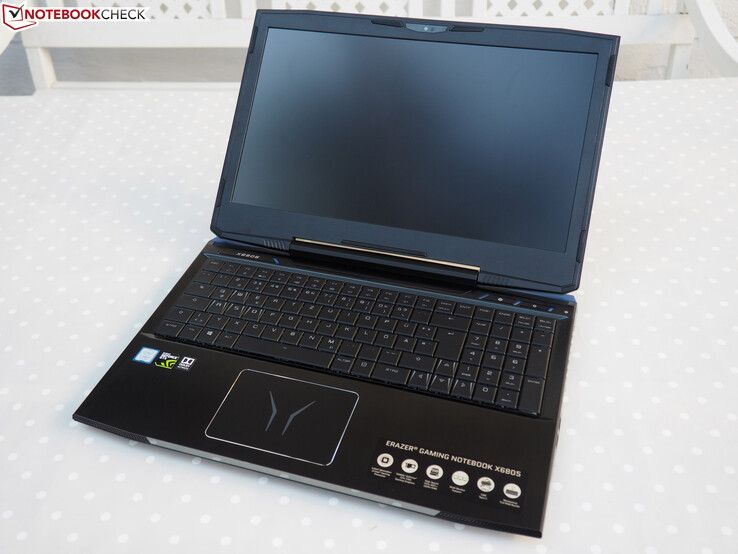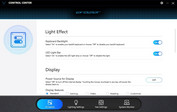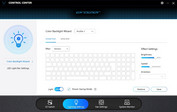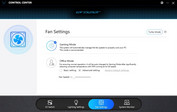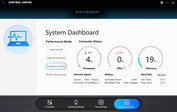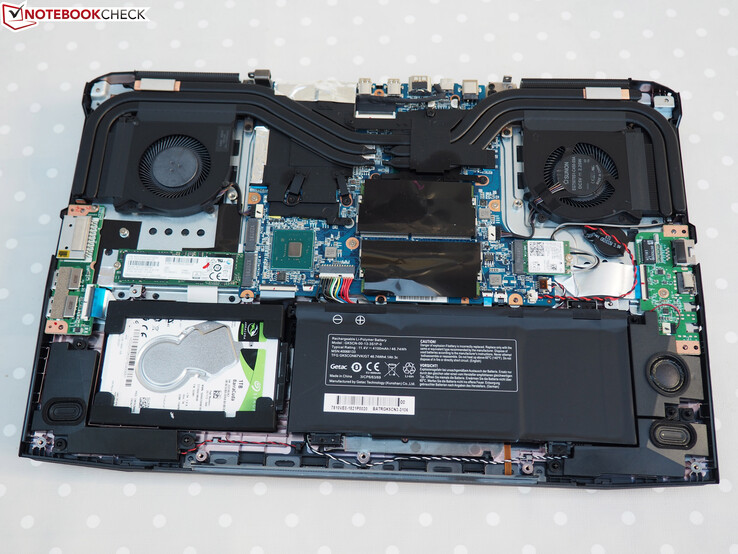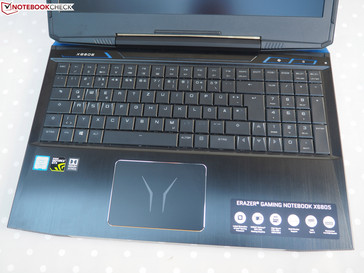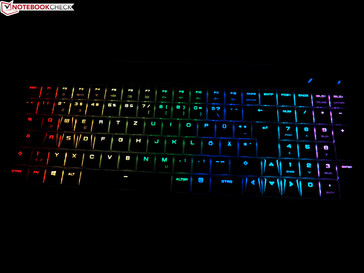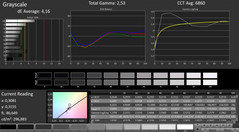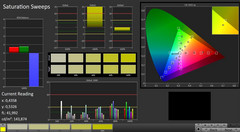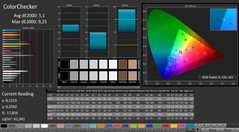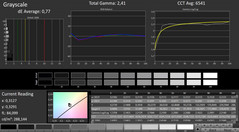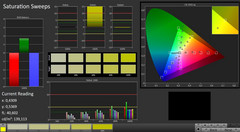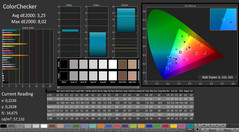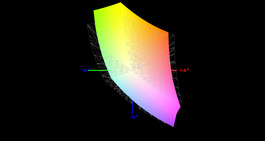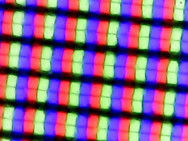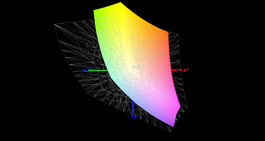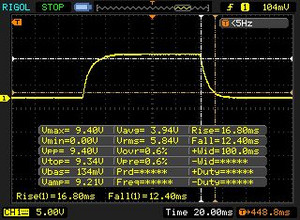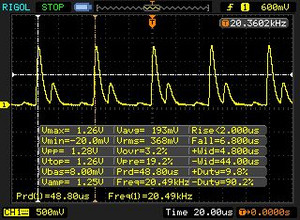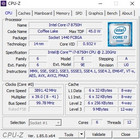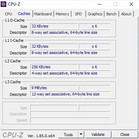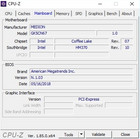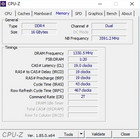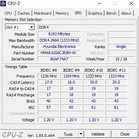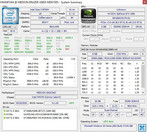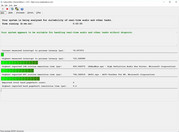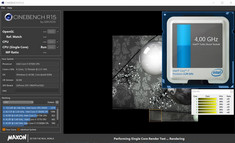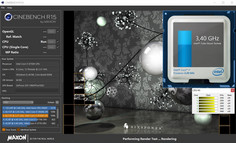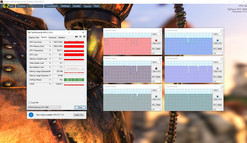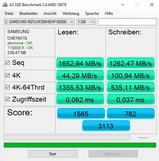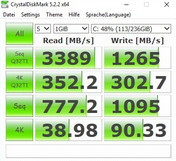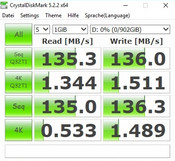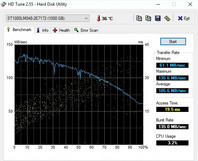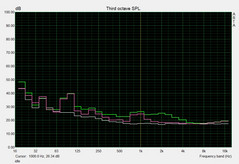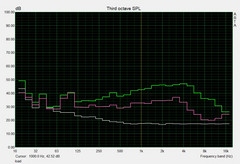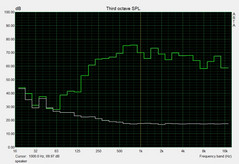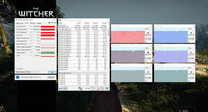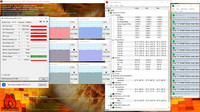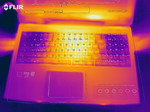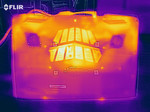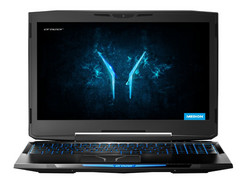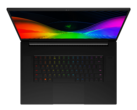Medion Erazer X6805 (Core i7-8750H, GTX 1060, FHD) Laptop Review

Medion is a German electronics company that is owned by Lenovo. The company currently sells through Aldi in the US and through retailers such as Argos in the UK. The price comparison website geizhals.de states that Medion currently sells six different versions of the X6805 that are distinguishable by the differing components with which they are equipped. All models have the same NVIDIA GeForce GTX 1060 GPU. The entry-level model is powered by an Intel Core i5-8300H quad-core processor, 8 GB of RAM, and a 256 GB SSD, but it does not come with an OS. By contrast, our test device is powered by a more powerful Core i7-8750H processor, has 16 GB of RAM, a 256 GB SSD and a 1 TB HDD. There is also a Core i7-8750H model with 8 GB of RAM and a 512 GB SSD or a Core i5-8300H version with 16 GB of RAM.
All models are equipped with a matte 15.6-inch IPS display that runs natively at 1,920x1080. The X6805 does not support NVIDIA G-Sync, but it utilises NVIDIA Optimus instead, which dynamically switches between the dedicated and integrated GPUs for improved energy efficiency. Medion has chosen to equip all X6805 models with NVIDIA GeForce GTX 1060 GPUs to keep costs down, but the GPU should be powerful enough for most tasks on the Full HD display. Our test device came with Windows 10 Home 64-Bit preinstalled too.
Prices currently start at €1,099 (~$1254) in Germany and rise to €1,399 (~$1597), which is the same price as our test device. By contrast, the entry-level model costs £949.99 in the UK at the time of writing, while the same configuration as our test device costs £1,249.99.
We have chosen to compare the X6805 against other budget 15-inch laptops. Our comparison devices include the Acer Nitro 5, the Dell G7, the HP Omen 15, the Lenovo Legion Y530, and the elusive Xiaomi Mi Gaming Laptop.
Case
One of the biggest surprises with the X6805 is its case. Since Lenovo has been a majority shareholder in Medion for several years, we would have expected the X6805 to have a refined IdeaPad or Legion-based case. However, Medion has used the case from the Tongfang GK5CN67, which is confirmed by a sticker on the underside of our test device.
Tongfang is a relatively unknown quantity in Europe and the US. We have seen other companies using Tongfang barebones cases though. The recently reviewed Schenker XMG Neo 15 and the Monster Tulpar T5 were based on a Tongfang GK5CN6Z. However, X6805 has much thicker display bezels than either of those two laptops, which makes the design look relatively outdated. Thicker bezels also increase the device’s footprint, but this increased space tends to help a laptop run cooler too than it could if it had a thinner case.
Our test device measures 38.5 cm wide and 26.5 cm (~15.2 x 10.4 in) deep, which makes the X6805 roughly the same size as the Acer Nitro 5 and the Dell G7. By contrast, the Lenovo Legion Y530, the HP Omen 15 and the Xiaomi Mi Gaming Laptop are all noticeably smaller thanks to their slimmer display bezels.
The X6805 is a chunky device though at 3.3 cm (~1.3 in) thick, which is visibly bulkier than all our comparison devices. However, the device only weighs 2.5 kg (~5.5 lb), which makes it a few hundred grams lighter than Dell G7 and the Xiaomi Mi Gaming Laptop.
Our test device is relatively well-built, particularly considering its price. The display lid and keyboard deck are made from brushed aluminium, which makes the X6805 feel premium and makes it more robust than if it were made entirely from plastic. Medion has clearly designed the X6805 to appeal to gamers, with its use of aggressive lines and blue accents across the entire device. The blue accents are only on when the machine is running, so the X6805 will look more inconspicuous when it is asleep or switched off. The device has a long hinge too, but this proved relatively unspectacular during our tests. The hinge is tight enough to allow for opening the display with one hand, but its size does not make it exceptionally sturdy.
Connectivity
Ports
The selection of ports is underwhelming. We expect to see at least a USB 3.1 Gen2 port for gaming laptops released in 2018, while the inclusion of a Thunderbolt 3 port is a welcome addition. However, Medion has equipped the X6805 with USB 3.0 and USB 2.0 ports. There are two USB 3.0 Type-A ports, one USB 2.0 Type-A port and a USB 3.0 Type-C port, the combination of which is somewhat disappointing.
The remaining ports are more up to date though. There is an HDMI 2.0 port on the rear of the device that is located next to two mini-DisplayPorts, which gives the X6805 a total of three wired video outputs. Gamers will also appreciate the dedicated headphone and microphone jacks, while the inclusion of an RJ45 Ethernet port will also prove useful for most gamers. A full-sized SD card reader and a Kensington lock slot round off the selection of ports.
The ports are also well spaced out, so you should not have any issues with connecting several peripherals at once. However, the indent on the back of the device makes the rear ports trickier to access than we would have liked.
SD Card reader
The performance of the card reader leaves much to be desired. The X6805 only achieves USB 2.0 speeds of around 30 MB/s like the Dell G7 and the Xiaomi Mi Gaming Laptop, which are much slower than the USB 3.0 speeds that the Acer Nitro 5 and the HP Omen manage. However, none of our comparison devices can achieve the 260 MB/s theoretical maximum of our reference SD card, but our test device’s performance in these tests is disappointing, nonetheless.
| SD Card Reader | |
| average JPG Copy Test (av. of 3 runs) | |
| Average of class Gaming (20 - 210, n=66, last 2 years) | |
| Acer Nitro 5 AN515-52-74DR (Toshiba Exceria Pro SDXC 64 GB UHS-II) | |
| HP Omen 15-dc0001ng (Toshiba Exceria Pro SDXC 64 GB UHS-II) | |
| Xiaomi Mi Gaming Laptop 7300HQ 1060 (Toshiba Exceria Pro SDXC 64 GB UHS-II) | |
| Dell G7 15-7588 (Toshiba Exceria Pro SDXC 64 GB UHS-II) | |
| Medion Erazer X6805-MD61085 (Toshiba Exceria Pro SDXC 64 GB UHS-II) | |
| maximum AS SSD Seq Read Test (1GB) | |
| Average of class Gaming (25.8 - 261, n=63, last 2 years) | |
| HP Omen 15-dc0001ng (Toshiba Exceria Pro SDXC 64 GB UHS-II) | |
| Acer Nitro 5 AN515-52-74DR (Toshiba Exceria Pro SDXC 64 GB UHS-II) | |
| Dell G7 15-7588 (Toshiba Exceria Pro SDXC 64 GB UHS-II) | |
| Medion Erazer X6805-MD61085 (Toshiba Exceria Pro SDXC 64 GB UHS-II) | |
| Xiaomi Mi Gaming Laptop 7300HQ 1060 (Toshiba Exceria Pro SDXC 64 GB UHS-II) | |
Communication
We cannot criticise Medion for its choice of Wi-Fi hardware though. The company has equipped our test device with an Intel Wireless-AC 9560 module, which exceeded 600 Mbit/s in both iperf3 Client tests that we conducted. This Wi-Fi performance puts the X6805 on par with all our comparison devices bar the Mi Gaming Laptop, which Xiaomi has equipped with an older Intel Wi-Fi card.
Please note: We used our Linksys EA8500 reference router for our Wi-Fi tests and conducted them with the X6805 around 1 metre (~3 ft) away from the router. No Wi-Fi connected devices blocked the path between our test device and the router either.
Software
We already know the central software, which Medion calls Control Center, from the XMG Neo 15 and the Tulpar T5. The software has controls for the keyboard RGB lighting, the LED strips, the fan, and the power mode among others. There is also a section for monitoring system performance and at what temperatures the machine is running. We left all settings as they were out of the box for our tests, which sets the fan mode to “Gaming Mode” by default.
Accessories
The Erazer comes with a warranty booklet, safety instructions and a 180-W power supply. The power supply is relatively compact at 15 x 7.5 x 2.5 cm (~5.9 x 2.9 x 1 in) and weighs just 400 g (~14 oz).
Maintenance
Maintaining the X6805 is unnecessarily complicated. There is no maintenance cover, so accessing any components requires unscrewing 20 screws to remove the bottom case. Moreover, we had to lift the blue plastic fan vents away from the case with a pry tool, which increases the risk of damaging some part of the device in the process. In short, the X6805 is harder to repair and maintain than it needs to be.
Warranty
The X6805 comes with a 24-month manufacturer’s warranty, which is the case for all Medion laptops. Please see our Guarantees, Return policies and Warranties FAQ for country-specific information.
Input Devices
Keyboard
Although mechanical keyboards are becoming more common, they are still a rarity even for gaming laptops. Medion deserves some respect in this regard because the X6805 has a decent keyboard that belies its budget pricing.
Mechanical keyboards feel much crisper and more accurate than their traditional laptop counterparts in our opinion, although they are noisier than chiclet keyboards. Hence, while the keys on our test device have a precise pressure point, the keyboard is too loud to use the X6805 in noise sensitive environments such as libraries. The keyboard will suit gamers who like to play at home though.
Speaking of gaming, Medion has added its Erazer branding to the directional arrows and the WASD keys, which helps them stand out from the other keys. This should help gamers acclimatise to the keyboard more quickly in our opinion. Another highlight of the keyboard is its per-key RGB lighting. There are also several lighting modes that should suit most people.
Moreover, the keys are generously sized, and Medion has even squeezed in a number pad, which is a bonus. Overall, the X6805 has an excellent keyboard for its price.
Trackpad
Unfortunately, the trackpad is not at the same high level as the keyboard. The trackpad measures 10.7 x 7.5 cm (~4.2 x 2.9 in), which is a decent size for a 15-inch device, while it has a smooth finish that is easy to slide across with a thumb or finger. However, the clicking mechanism is sub-optimal and makes actions, such as selecting text or dragging and dropping something, a chore. The mechanism is also noisy and is unstable on the left and right-hand sides of the trackpad.
Multi-finger gestures are easy to perform though, which is a positive. Two-finger gestures such as zooming and scrolling worked reliably during our tests, so you should have no issues with performing such actions in daily use.
Display
We suspect that people who can manage with a 60 Hz display will like the one with which Medion has equipped the X6805. The display does not support NVIDIA G-Sync either, but it performed respectably compared to the screens in our comparison devices.
| |||||||||||||||||||||||||
Brightness Distribution: 86 %
Center on Battery: 270 cd/m²
Contrast: 844:1 (Black: 0.32 cd/m²)
ΔE ColorChecker Calman: 5.1 | ∀{0.5-29.43 Ø4.78}
calibrated: 3.25
ΔE Greyscale Calman: 4.16 | ∀{0.09-98 Ø5}
82% sRGB (Argyll 1.6.3 3D)
54% AdobeRGB 1998 (Argyll 1.6.3 3D)
60.3% AdobeRGB 1998 (Argyll 3D)
82.4% sRGB (Argyll 3D)
63.8% Display P3 (Argyll 3D)
Gamma: 2.53
CCT: 6860 K
| Medion Erazer X6805-MD61085 LG Philips LP156WF6 (LGD046F), IPS, 1920x1080 | Xiaomi Mi Gaming Laptop 7300HQ 1060 BOEhydis NV156FHM-N61 (BOE0747), IPS, 1920x1080 | Dell G7 15-7588 LG Philips LGD053F, IPS, 1920x1080 | Acer Nitro 5 AN515-52-74DR LG Philips LP156WF6-SPK6 (LGD0590), IPS, 1920x1080 | HP Omen 15-dc0001ng BOE07A1, IPS, 1920x1080 | Lenovo Legion Y530-15ICH B156HAN02.1, IPS, 1920x1080 | |
|---|---|---|---|---|---|---|
| Display | 5% | -36% | -33% | -33% | -35% | |
| Display P3 Coverage (%) | 63.8 | 66.6 4% | 37.82 -41% | 39.59 -38% | 39.64 -38% | 38.31 -40% |
| sRGB Coverage (%) | 82.4 | 87.3 6% | 56.2 -32% | 59.5 -28% | 59 -28% | 57.3 -30% |
| AdobeRGB 1998 Coverage (%) | 60.3 | 63.8 6% | 39.2 -35% | 40.92 -32% | 40.95 -32% | 39.58 -34% |
| Response Times | -41% | 4% | 13% | -17% | -13% | |
| Response Time Grey 50% / Grey 80% * (ms) | 38.4 ? | 53.2 ? -39% | 38.8 ? -1% | 38 ? 1% | 47.2 ? -23% | 43.6 ? -14% |
| Response Time Black / White * (ms) | 29.2 ? | 41.6 ? -42% | 26.8 ? 8% | 22 ? 25% | 32.4 ? -11% | 32.4 ? -11% |
| PWM Frequency (Hz) | 20490 ? | 21550 ? | 200 ? | |||
| Screen | 12% | -41% | 4% | -1% | -19% | |
| Brightness middle (cd/m²) | 270 | 283 5% | 250.9 -7% | 252 -7% | 275 2% | 282.8 5% |
| Brightness (cd/m²) | 269 | 269 0% | 246 -9% | 237 -12% | 254 -6% | 264 -2% |
| Brightness Distribution (%) | 86 | 87 1% | 89 3% | 86 0% | 90 5% | 88 2% |
| Black Level * (cd/m²) | 0.32 | 0.23 28% | 0.34 -6% | 0.21 34% | 0.27 16% | 0.42 -31% |
| Contrast (:1) | 844 | 1230 46% | 738 -13% | 1200 42% | 1019 21% | 673 -20% |
| Colorchecker dE 2000 * | 5.1 | 4.68 8% | 7.34 -44% | 4.42 13% | 4.62 9% | 4.93 3% |
| Colorchecker dE 2000 max. * | 9.25 | 8 14% | 28.66 -210% | 7.21 22% | 8.05 13% | 17.65 -91% |
| Colorchecker dE 2000 calibrated * | 3.25 | 2.5 23% | 4.42 -36% | 3.08 5% | 3.59 -10% | 4.07 -25% |
| Greyscale dE 2000 * | 4.16 | 4.32 -4% | 6.8 -63% | 3.74 10% | 4.31 -4% | 3.8 9% |
| Gamma | 2.53 87% | 2.36 93% | 2.164 102% | 2.34 94% | 2.49 88% | 2.449 90% |
| CCT | 6860 95% | 7612 85% | 6780 96% | 7291 89% | 7000 93% | 6112 106% |
| Color Space (Percent of AdobeRGB 1998) (%) | 54 | 57 6% | 36 -33% | 38 -30% | 38 -30% | 36 -33% |
| Color Space (Percent of sRGB) (%) | 82 | 87 6% | 56 -32% | 59 -28% | 59 -28% | 57 -30% |
| Total Average (Program / Settings) | -8% /
4% | -24% /
-34% | -5% /
-1% | -17% /
-9% | -22% /
-21% |
* ... smaller is better
Our test achieved an average maximum brightness of 270 cd/m², which is on par with our comparison devices. Moreover, its 0,32 cd/m² black value helps the X6805 achieve a 844:1 contrast ratio, which is higher than the contrast ratios of the Dell G7 and the Legion Y530. However, the contrast ratios of our other comparison devices all exceed 1,000:1, which is what we have come to expect from better consumer and gaming laptops.
The X6805 has a comparably colour accurate display though. Our test device covers 82% of sRGB and 54% of AdobeRGB colour spaces, which is much higher than many of our comparison devices. Only the Xiaomi Mi Gaming Laptop is more colour accurate in this regard.
Unfortunately, our test device suffers from backlight bleeding. There is a noticeable halo in the upper-right corner of the screen, which is disappointing. The response times are typical for a Full HD IPS display though. Our tests determined that the X6805 takes 29 ms when switching from black to white and 38 ms when changing from grey to grey, which is weak on paper. We did not notice any significant streaking when playing first-person shooters, so the poor response times do not correspond with our experiences in daily use.
The X6805 also uses pulse-width modulation (PWM) to regulate its display brightness. We measured a PWM frequency of 20,490 Hz at 99% brightness and below, which should be high enough not to cause issues for people even if they are PWM sensitive.
Display Response Times
| ↔ Response Time Black to White | ||
|---|---|---|
| 29.2 ms ... rise ↗ and fall ↘ combined | ↗ 16.8 ms rise | |
| ↘ 12.4 ms fall | ||
| The screen shows relatively slow response rates in our tests and may be too slow for gamers. In comparison, all tested devices range from 0.1 (minimum) to 240 (maximum) ms. » 77 % of all devices are better. This means that the measured response time is worse than the average of all tested devices (20.2 ms). | ||
| ↔ Response Time 50% Grey to 80% Grey | ||
| 38.4 ms ... rise ↗ and fall ↘ combined | ↗ 18.8 ms rise | |
| ↘ 19.6 ms fall | ||
| The screen shows slow response rates in our tests and will be unsatisfactory for gamers. In comparison, all tested devices range from 0.165 (minimum) to 636 (maximum) ms. » 56 % of all devices are better. This means that the measured response time is worse than the average of all tested devices (31.6 ms). | ||
Screen Flickering / PWM (Pulse-Width Modulation)
| Screen flickering / PWM detected | 20490 Hz | ≤ 99 % brightness setting | |
The display backlight flickers at 20490 Hz (worst case, e.g., utilizing PWM) Flickering detected at a brightness setting of 99 % and below. There should be no flickering or PWM above this brightness setting. The frequency of 20490 Hz is quite high, so most users sensitive to PWM should not notice any flickering. In comparison: 53 % of all tested devices do not use PWM to dim the display. If PWM was detected, an average of 8108 (minimum: 5 - maximum: 343500) Hz was measured. | |||
Performance
The configuration of our test device is equipped with well-balanced hardware. The NVIDIA GeForce GTX 1060 GPU is powerful enough to render most games at high graphics on the X6805’s 1080p display, and is supported by an Intel Core i7-8750H hexa-core processor. These two components are complemented by two modules of 8 GB of DDR4-2666 RAM and a PCIe SSD. In short, the X6805 should still be powerful enough in a few years to handle the latest triple-A games at decent graphics settings.
Processor
Although the quad-core Core i5-8300H is a good companion for the GeForce GTX 1060, we would suggest going for an X6805 with the more powerful Core i7-8750H, as it is not a huge leap in cost. The Core i7-8750H has two more cores than its Core i5 sibling, which results in 4 more threads thanks to support for Intel Hyper-Threading.
Our test device performed admirably in CPU benchmarks. The X6805 finished in first place in our Cinebench R15 and Cinebench R11.5 multi-core comparison tables. The X6805 is around 30% more powerful than laptops that are equipped with a Core i5-8300H processor, and at least 10% more powerful than Core i7-8750H powered laptops in CB R15.
We also subjected the X6805 to a looped CB R15 multi-core benchmark to determine how well it manages its performance under sustained load. Our test device performs like many other Coffee Lake powered laptops, and only maintains its turbo boost clock speeds for a short period. CB R15 scores dropped by around 10% after four pass-throughs of the benchmark and fluctuated around 1,100 points for the remainder of the CB R15 loop. Notably, the CPU varied between 2.7 GHz and 3.9 GHz during the first run through of CB R15 and averaged 3.4 GHz, which is several MHz short of its maximum clock speed.
System Performance
The system performance of the X6805 is excellent. Our test device leads the way with the Dell G7 in PCMark 10 and PCMark 8 and is well ahead of our other comparison devices. Our test device suffered from the known NVIDIA Optimus bug though, as do many laptops that are equipped with discrete NVIDIA GPUs. Overall, Windows 10 feels snappy on our test device, with the system booting and loading applications or executing file transfers quickly.
| PCMark 8 Home Score Accelerated v2 | 4404 points | |
| PCMark 8 Work Score Accelerated v2 | 5379 points | |
| PCMark 10 Score | 5234 points | |
Help | ||
Storage Devices
The choice of SSD is partially responsible for the first-class system performance benchmark scores. Medion has equipped our test device with a Samsung PM961 PCIe SSD, which is currently one of the fastest SSDs on the market. None of our comparison devices can compete with the X6805 on SSD performance according to the AS SSD benchmark.
Medion has equipped the X6805 with three drive bays should you need more storage, of which two are occupied in our test device. A 1 TB Seagate Barracuda ST1000LM048, 5,400 RPM HDD, complements the Samsung PM961, but there is also an additional M.2 2280 slot, which makes the X6805 an impressively equipped device considering its price. You could even run two PM961 SSDs in a RAID for faster transfer speeds.
| Medion Erazer X6805-MD61085 Samsung PM961 MZVLW256HEHP | Xiaomi Mi Gaming Laptop 7300HQ 1060 Samsung PM871b MZNLN128HAHQ | Dell G7 15-7588 SK hynix SC311 SATA | Acer Nitro 5 AN515-52-74DR Intel SSD 600p SSDPEKKW512G7 | HP Omen 15-dc0001ng Toshiba KBG30ZMV128G | Lenovo Legion Y530-15ICH Toshiba KBG30ZMT128G | |
|---|---|---|---|---|---|---|
| AS SSD | -51% | -69% | -32% | -56% | -60% | |
| Seq Read (MB/s) | 1653 | 502 -70% | 506 -69% | 1321 -20% | 1238 -25% | 1231 -26% |
| Seq Write (MB/s) | 1262 | 450.1 -64% | 220.3 -83% | 554 -56% | 123.5 -90% | 131.6 -90% |
| 4K Read (MB/s) | 44.29 | 38.11 -14% | 23.66 -47% | 32.38 -27% | 31.48 -29% | 38.71 -13% |
| 4K Write (MB/s) | 100.9 | 104.1 3% | 59.8 -41% | 94.5 -6% | 79.3 -21% | 35.74 -65% |
| Score Read (Points) | 1565 | 343 -78% | 233 -85% | 670 -57% | 343 -78% | 497 -68% |
| Score Write (Points) | 762 | 302 -60% | 181 -76% | 661 -13% | 195 -74% | 128 -83% |
| Score Total (Points) | 3113 | 834 -73% | 528 -83% | 1643 -47% | 670 -78% | 838 -73% |
Graphics Card
The X6805 is equipped with an NVIDIA GeForce GTX 1060, which is currently one of the most successful and popular gaming GPUs on the market. The Pascal-based GPU can render most games smoothly at 1080p at high to maximum details.
Most comparably priced laptops are equipped with a weaker GeForce GTX 1050 Ti GPU, which makes the X6805 even better value for money. Our test device scores around 50% higher in the 3DMark Fire Strike benchmark, which underlines how much more powerful the GeForce GTX 1060 is compared to the GeForce GTX 1050 Ti. It is also worth keeping in mind that the performance of the GeForce GTX 1060 Max-Q is almost on par with a standard GeForce GTX 1060, so we would have no hesitation in recommending both GPUs.
| 3DMark 11 Performance | 13648 points | |
| 3DMark Cloud Gate Standard Score | 33333 points | |
| 3DMark Fire Strike Score | 10351 points | |
Help | ||
We subjected our test device to an hour’s playthrough of "The Witcher 3" at 1080p on Ultra graphics to see whether the GPU thermal throttled. The GeForce GTX 1060 maintained its 1,600 MHz turbo clock speed throughout our load test, which is much higher than its 1,405 MHz base clock speed. Hence, the X6805 should not throttle when gaming.
Gaming Performance
As we have already indicated, the GeForce GTX 1060 rarely has problems with rendering games at Full HD. All 8 games that we tested averaged at least 40 FPS when played on Ultra graphics. Purchasing a more expensive laptop with a GeForce GTX 1070 or GeForce GTX 1080 would only be worth it in our opinion if you want to game at QHD or UHD on a high refresh rate display.
| The Witcher 3 | |
| 1920x1080 Ultra Graphics & Postprocessing (HBAO+) | |
| Average of class Gaming (18.4 - 240, n=55, last 2 years) | |
| Xiaomi Mi Gaming Laptop 7300HQ 1060 | |
| Medion Erazer X6805-MD61085 | |
| Lenovo Legion Y530-15ICH | |
| Dell G7 15-7588 | |
| Acer Nitro 5 AN515-52-74DR | |
| HP Omen 15-dc0001ng | |
| 1920x1080 High Graphics & Postprocessing (Nvidia HairWorks Off) | |
| Average of class Gaming (110 - 424, n=35, last 2 years) | |
| Xiaomi Mi Gaming Laptop 7300HQ 1060 | |
| Medion Erazer X6805-MD61085 | |
| Dell G7 15-7588 | |
| Acer Nitro 5 AN515-52-74DR | |
| HP Omen 15-dc0001ng | |
Please keep in mind that the CPU and GPU throttle to between 800-1200 MHz on battery, which corresponds with a 60% drop in performance. This behaviour happens with numerous gaming laptops though, so it is nothing about which potential buyers should worry. We would just recommend gaming with the X6805 running on mains power.
| low | med. | high | ultra | |
|---|---|---|---|---|
| The Witcher 3 (2015) | 72.1 | 39.5 | ||
| Destiny 2 (2017) | 93.8 | 81.3 | ||
| Wolfenstein II: The New Colossus (2017) | 85.2 | 78.7 | ||
| Call of Duty WWII (2017) | 94.5 | 68.2 | ||
| The Crew 2 (2018) | 60 | 59.9 | ||
| Monster Hunter World (2018) | 56.5 | 44.9 | ||
| F1 2018 (2018) | 97 | 60 | ||
| Shadow of the Tomb Raider (2018) | 56 | 49 |
Emissions
Fan Noise
The X6805 could manage its fan noise better in our opinion. The GeForce GTX 1060 reached around 70 °C (~158 °F) during our "The Witcher 3" stress test, and the Core i7-8750H fluctuated between 60-70 °C (~140-158 °F), which are respectable core temperatures. However, the fans ramp up to a noisy 47 dB(A), which means that you can only game with headphones or external speakers connected. Moreover, a combined FurMark and Prime95 stress test caused the fans to reach a maximum of 56 dB(A), which is an annoyingly loud and is much noisier than the cooling solutions in our comparison devices. Fortunately, the X6805 has a manual control in the Control Center program, which can noticeably reduce fan noise when the machine is pushed hard. You could also choose from one of the fan presets should you not want to tinker with fan curves.
Our test device runs comparatively quietly at idle though, which is a bonus. The machine even occasionally runs silently when the HDD switches off, although the fan spin up during the simplest of tasks such as browsing the web or watching a video. Predictably, the fans turn on when Windows is installing a program or a system update.
Noise level
| Idle |
| 29 / 32 / 35 dB(A) |
| HDD |
| 32 dB(A) |
| Load |
| 45 / 56 dB(A) |
 | ||
30 dB silent 40 dB(A) audible 50 dB(A) loud |
||
min: | ||
| Medion Erazer X6805-MD61085 GeForce GTX 1060 Mobile, i7-8750H | Xiaomi Mi Gaming Laptop 7300HQ 1060 GeForce GTX 1060 Mobile, i5-7300HQ | Dell G7 15-7588 GeForce GTX 1060 Max-Q, i7-8750H | Acer Nitro 5 AN515-52-74DR GeForce GTX 1050 Ti Mobile, i7-8750H | HP Omen 15-dc0001ng GeForce GTX 1050 Ti Mobile, i5-8300H | Lenovo Legion Y530-15ICH GeForce GTX 1050 Ti Mobile, i5-8300H | Average of class Gaming | |
|---|---|---|---|---|---|---|---|
| Noise | -3% | 6% | 3% | -1% | 12% | 10% | |
| off / environment * (dB) | 29 | 30 -3% | 28.1 3% | 30 -3% | 29 -0% | 28 3% | 24.1 ? 17% |
| Idle Minimum * (dB) | 29 | 30 -3% | 29 -0% | 30 -3% | 29 -0% | 28 3% | 26.1 ? 10% |
| Idle Average * (dB) | 32 | 34 -6% | 29 9% | 32 -0% | 33 -3% | 28 12% | 27.7 ? 13% |
| Idle Maximum * (dB) | 35 | 38 -9% | 29.2 17% | 33 6% | 41 -17% | 28.5 19% | 30.2 ? 14% |
| Load Average * (dB) | 45 | 44 2% | 40.6 10% | 42 7% | 44 2% | 34.9 22% | 43 ? 4% |
| Witcher 3 ultra * (dB) | 47 | 50 -6% | 49.8 -6% | 46 2% | 47 -0% | 40 15% | |
| Load Maximum * (dB) | 56 | 55 2% | 49.8 11% | 49 12% | 49 12% | 49.6 11% | 53.8 ? 4% |
* ... smaller is better
Temperature
The X6805 manages its temperatures relatively well. The bottom case reaches a maximum of 50 °C (~122 °F) under full load, so we would not recommend gaming with the device on your lap. However, the palm rest never gets hotter than 32 °C (~90 °F) , which is rare for a gaming laptop. Moreover, the entire case remains pleasantly cool at idle and never exceeds 30 °C (~86 °F).
Our test device manages its temperatures well internally too. The CPU does not exceed the 90 °C (~194 °F) mark even during a combined stress test, which is impressive. In contrast, the GPU throttles to around 1,200 MHz, which then causes the GPU core temperatures to drop below their average during our "The Witcher 3" stress test.
(±) The maximum temperature on the upper side is 43 °C / 109 F, compared to the average of 40.4 °C / 105 F, ranging from 21.2 to 68.8 °C for the class Gaming.
(-) The bottom heats up to a maximum of 55 °C / 131 F, compared to the average of 43.3 °C / 110 F
(+) In idle usage, the average temperature for the upper side is 26 °C / 79 F, compared to the device average of 33.9 °C / 93 F.
(±) Playing The Witcher 3, the average temperature for the upper side is 37.1 °C / 99 F, compared to the device average of 33.9 °C / 93 F.
(+) The palmrests and touchpad are reaching skin temperature as a maximum (32 °C / 89.6 F) and are therefore not hot.
(-) The average temperature of the palmrest area of similar devices was 28.9 °C / 84 F (-3.1 °C / -5.6 F).
| Medion Erazer X6805-MD61085 GeForce GTX 1060 Mobile, i7-8750H | Xiaomi Mi Gaming Laptop 7300HQ 1060 GeForce GTX 1060 Mobile, i5-7300HQ | Dell G7 15-7588 GeForce GTX 1060 Max-Q, i7-8750H | Acer Nitro 5 AN515-52-74DR GeForce GTX 1050 Ti Mobile, i7-8750H | HP Omen 15-dc0001ng GeForce GTX 1050 Ti Mobile, i5-8300H | Lenovo Legion Y530-15ICH GeForce GTX 1050 Ti Mobile, i5-8300H | Average of class Gaming | |
|---|---|---|---|---|---|---|---|
| Heat | -6% | 5% | -14% | -17% | -10% | -5% | |
| Maximum Upper Side * (°C) | 43 | 46 -7% | 48.6 -13% | 52 -21% | 51 -19% | 42.8 -0% | 45.6 ? -6% |
| Maximum Bottom * (°C) | 55 | 52 5% | 51.4 7% | 55 -0% | 58 -5% | 52 5% | 48.3 ? 12% |
| Idle Upper Side * (°C) | 28 | 32 -14% | 24 14% | 36 -29% | 35 -25% | 32 -14% | 31.4 ? -12% |
| Idle Bottom * (°C) | 30 | 32 -7% | 26.8 11% | 32 -7% | 35 -17% | 39.4 -31% | 34.3 ? -14% |
* ... smaller is better
Speakers
Few laptops have good speakers, but the X6805 is one of them. The device has two speakers and a subwoofer, which reproduces bass tones much better than our comparison devices. Moreover, mid and high tones sound clear. In short, the X6805 has excellent laptop speakers, but you will still get a better listening experience from decent headphones or external speakers.
Medion Erazer X6805-MD61085 audio analysis
(+) | speakers can play relatively loud (82 dB)
Bass 100 - 315 Hz
(±) | reduced bass - on average 11.2% lower than median
(±) | linearity of bass is average (9.6% delta to prev. frequency)
Mids 400 - 2000 Hz
(+) | balanced mids - only 4.9% away from median
(±) | linearity of mids is average (8.2% delta to prev. frequency)
Highs 2 - 16 kHz
(+) | balanced highs - only 2.9% away from median
(±) | linearity of highs is average (7.8% delta to prev. frequency)
Overall 100 - 16.000 Hz
(+) | overall sound is linear (13.5% difference to median)
Compared to same class
» 19% of all tested devices in this class were better, 7% similar, 74% worse
» The best had a delta of 6%, average was 18%, worst was 132%
Compared to all devices tested
» 14% of all tested devices were better, 4% similar, 83% worse
» The best had a delta of 4%, average was 24%, worst was 134%
Xiaomi Mi Gaming Laptop 7300HQ 1060 audio analysis
(+) | speakers can play relatively loud (88 dB)
Bass 100 - 315 Hz
(±) | reduced bass - on average 13.5% lower than median
(±) | linearity of bass is average (8.5% delta to prev. frequency)
Mids 400 - 2000 Hz
(+) | balanced mids - only 4.6% away from median
(+) | mids are linear (5% delta to prev. frequency)
Highs 2 - 16 kHz
(+) | balanced highs - only 2.6% away from median
(+) | highs are linear (4.4% delta to prev. frequency)
Overall 100 - 16.000 Hz
(+) | overall sound is linear (13.2% difference to median)
Compared to same class
» 18% of all tested devices in this class were better, 4% similar, 77% worse
» The best had a delta of 6%, average was 18%, worst was 132%
Compared to all devices tested
» 13% of all tested devices were better, 3% similar, 84% worse
» The best had a delta of 4%, average was 24%, worst was 134%
Power Management
Power Consumption
The X6805 supports NVIDIA Optimus, which helps reduce power consumption by switching to the more efficient integrated GPU during general tasks such as web browsing. Our test device consumes between 10-21 W at idle, which is good, although many of our comparison devices consume less. Power consumption rises to a maximum of 176 W under load which, again, is noticeably higher than our comparison devices.
| Off / Standby | |
| Idle | |
| Load |
|
Key:
min: | |
| Medion Erazer X6805-MD61085 GeForce GTX 1060 Mobile, i7-8750H | Xiaomi Mi Gaming Laptop 7300HQ 1060 GeForce GTX 1060 Mobile, i5-7300HQ | Dell G7 15-7588 GeForce GTX 1060 Max-Q, i7-8750H | Acer Nitro 5 AN515-52-74DR GeForce GTX 1050 Ti Mobile, i7-8750H | HP Omen 15-dc0001ng GeForce GTX 1050 Ti Mobile, i5-8300H | Lenovo Legion Y530-15ICH GeForce GTX 1050 Ti Mobile, i5-8300H | Average of class Gaming | |
|---|---|---|---|---|---|---|---|
| Power Consumption | 13% | 29% | 33% | 6% | 27% | -34% | |
| Idle Minimum * (Watt) | 10 | 10 -0% | 5.5 45% | 5 50% | 12 -20% | 4.5 55% | 13.6 ? -36% |
| Idle Average * (Watt) | 13 | 13 -0% | 7.6 42% | 7 46% | 14 -8% | 10 23% | 19.5 ? -50% |
| Idle Maximum * (Watt) | 21 | 19 10% | 9 57% | 11 48% | 18 14% | 13.8 34% | 26.1 ? -24% |
| Load Average * (Watt) | 101 | 68 33% | 94 7% | 91 10% | 92 9% | 92.5 8% | 110.9 ? -10% |
| Witcher 3 ultra * (Watt) | 126 | 110 13% | 116.3 8% | 97 23% | 100 21% | 108.1 14% | |
| Load Maximum * (Watt) | 176 | 136 23% | 154.4 12% | 137 22% | 142 19% | 123.2 30% | 262 ? -49% |
* ... smaller is better
Battery Life
The X6805 has a 46.7 Wh battery, the capacity of which is comparatively poor compared to the batteries in many gaming laptops. Unfortunately, our first test device stopped working before we could conduct our battery life tests, but Medion kindly sent us a second so that we could do so.
In short, the X6805 has decent battery life despite its meagre battery capacity. Our test device lasted around 8.5 hours at idle and 4.5 hours during our Wi-Fi battery life test with the display set to approximately 150 cd/m². However, the Dell G7, Acer Nitro 5 and the HP Omen 15 all achieve considerably longer runtimes than the X6805.
| Medion Erazer X6805-MD61085 GeForce GTX 1060 Mobile, i7-8750H, 46.7 Wh | Xiaomi Mi Gaming Laptop 7300HQ 1060 GeForce GTX 1060 Mobile, i5-7300HQ, 55 Wh | Dell G7 15-7588 GeForce GTX 1060 Max-Q, i7-8750H, 56 Wh | Acer Nitro 5 AN515-52-74DR GeForce GTX 1050 Ti Mobile, i7-8750H, 48 Wh | HP Omen 15-dc0001ng GeForce GTX 1050 Ti Mobile, i5-8300H, 70 Wh | Lenovo Legion Y530-15ICH GeForce GTX 1050 Ti Mobile, i5-8300H, 52.5 Wh | Average of class Gaming | |
|---|---|---|---|---|---|---|---|
| Battery runtime | -14% | 45% | 33% | 43% | -9% | 20% | |
| Reader / Idle (h) | 8.4 | 6.4 -24% | 10.9 30% | 12.5 49% | 10.4 24% | 9.99 ? 19% | |
| WiFi v1.3 (h) | 4.5 | 4.6 2% | 7.5 67% | 7 56% | 8.6 91% | 4.1 -9% | 6.76 ? 50% |
| Load (h) | 1.6 | 1.3 -19% | 2.2 38% | 1.5 -6% | 1.8 13% | 1.435 ? -10% | |
| H.264 (h) | 4.4 | 7.1 | 8.4 | 8.1 ? |
Verdict
Pros
Cons
The Medion Erazer X6805 is excellent value for money. Most budget gaming laptops are equipped with a Core i5-8300H CPU, a GeForce GTX 1050 Ti, 8 GB of RAM, and a 128GB SSD. Medion has gone a step further though and armed its X6805 with a Core i7-8750H CPU, a GeForce GTX 1060 GPU, 16 GB of RAM and a 256 GB PCIe SSD.
The inclusion of a mechanical keyboard is an unusual but smart move for a device at this price. Moreover, the RGB lighting and the robust case should appeal to gamers. The speakers and port selection are decent too, although we would have liked to see Thunderbolt 3 or at least a USB 3.1 Gen2 port.
The Medion Erazer X6805 is powerful and well-designed budget gaming laptop that is not held back by its shortcomings.
Medion could have also equipped the X6805 with a faster SD card reader and tweaked the default fan curve. Additionally, the device would have benefited from an option for a larger battery in lieu of the HDD. Regardless, we wholeheartedly recommend the Medion Erazer X6805 as it is one of the best budget gaming laptops around.
Medion Erazer X6805-MD61085
- 09/28/2018 v6 (old)
Florian Glaser




